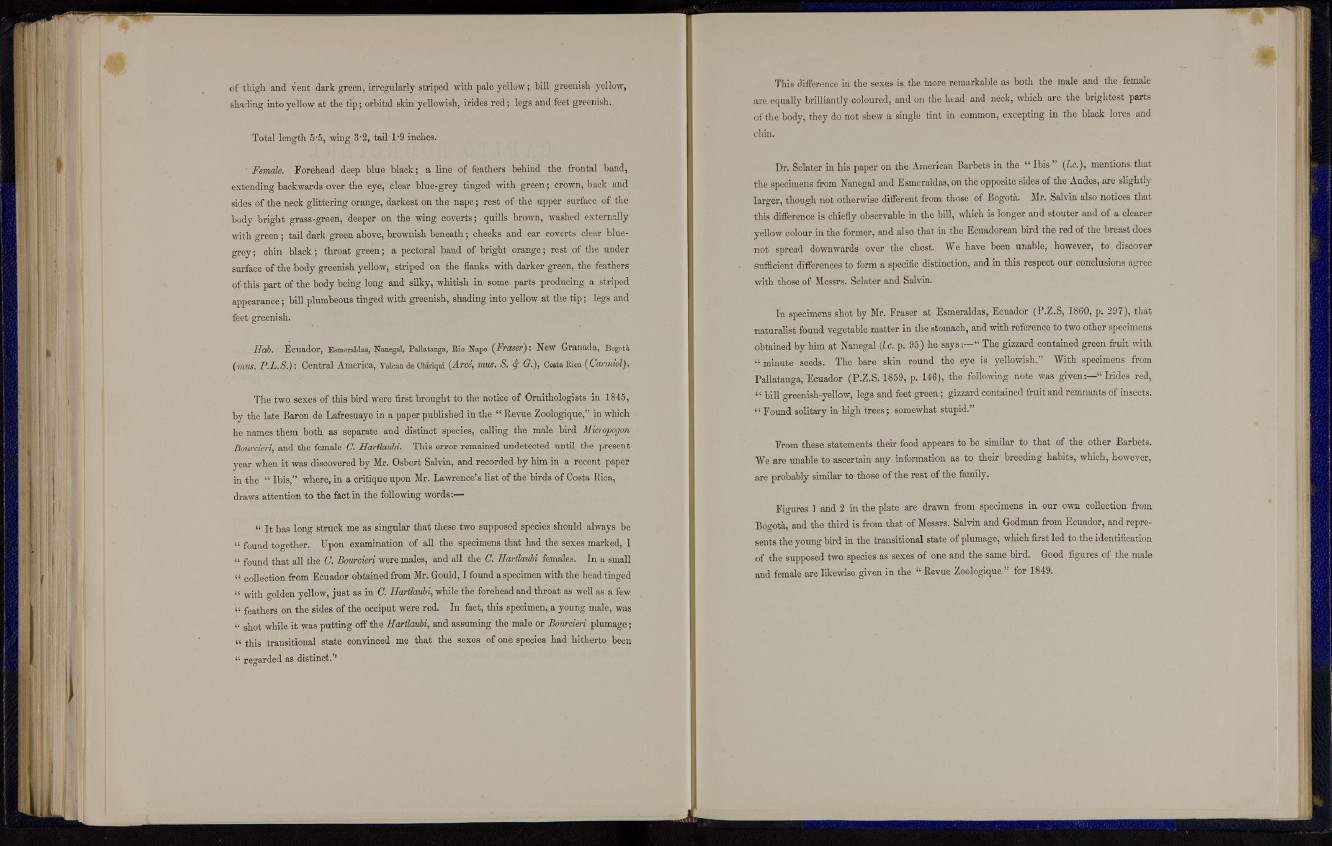
of thigh and vent dark green, irregularly striped with pale yellow; bill greenish yellow,
shading into yellow at the t i p ; orbital skin yellowish, irides r e d ; legs and feet greenish.
Total length 5*5, wing 3*2, tad 1*9 inches.
Female. Forehead deep blue black; a line of feathers behind the frontal band,
extending back wards over the eye, clear blue-grey tinged with green; crown, back and
sides of t h e neck glittering orange, darkest on t h e nape; rest of t h e upper surface of t he
body bright grass-green, deeper on t h e wing coverts; quills brown, washed externally
with green; tail dark green above, brownish beneath; cheeks and ear coverts clear bluegrey
; chin black; throat green; a pectoral band of bright orange; rest of the under
surface of t h e bod)' greenish yellow, striped on the flanks with darker green, the feathers
of this part of t h e body being long and silky, whitish in some parts producing a striped
appearance; bill plumbeous tinged with greenish, shading into yellow at t h e t i p ; legs and
feet greenish.
I fab. Ecuador, Esmeraldas, Nanegal, Pallatanga, Eio Napo (Fraser): New Granada, Bogota
(mm. P.L.S.): Central America, Volcan de Chiriqui (Arce, mus. S. $• G.), Costa Rica (Carmiol).
The two sexes of this bird were first brought to the notice of Ornithologists in 1845,
by the late Baron de Lafresuaye in a paper published in t h e " Revue Zoologique," in which
he names them both as separate and distinct species, calling the male bird Micropogon
Bourcieri, and t he female C. Hartlaubi. This error remained undetected untd the present
year when i t was discovered by Mr. Osbert Salvin, and recorded b y h im in a recent paper
in the " I b i s , " where, in a critique upon Mr. Lawrence's list of the birds of Costa Rica,
draws attention t o t h e fact in t h e following words:—
" I t has long struck me as singular t h a t these two supposed species should always be
" found together. Upon examination of all the specimens that had t he sexes marked, I
" found that all the C. Bourcieri were males, and all the C. Hartlaubi females. In a small
" collection from Ecuador obtained from Mr. Gould, I found a specimen with the head tinged
" with golden yellow, j u s t as in C. Hartlaubi, while the forehead and throat as well as a few
" feathers on t h e sides of t h e occiput were red. In fact, tins specimen, a young male, was
" shot while i t was putting off t h e Hartlaubi, and assuming the male or Bourcieri plumage;
" this transitional state convinced me that the sexes of one species had hitherto been
'• regarded as distinct.''
This difference in the sexes is the more remarkable as both the male and t h e female
are equally brilliantly coloured, and on the head and neck, which are t h e brightest parts
of the body, they do not shew a single tint in common, excepting in the black lores and
chin.
Dr. Sclater in his paper on the American Barbets in the " Ibis " (/.<".), mentions that
the specimens from Nanegal and Esmeraldas, on t h e opposite sides of the Andes, are slightlylarger,
though not otherwise different from those of Bogotá. Mr. Salvin also notices that
this difference is chiefly observable in the bill, which is longer and stouter and of a clearer
yellow colour in the former, and also that in the Ecuadorean bird the r ed of the breast does
not spread downwards over the chest. We have been unable, however, to discover
sufficient differences to form a specific distinction, and in this respect our conclusions agree
with those of Messrs. Sclater and Salvin.
In specimens shot by Mr. Fraser at Esmeraldas, Ecuador (I'.Z.S, 18G0, p. 297), that
naturalist found vegetable matter in t h e stomach, and with reference t o t w o other specimens
obtained by him at Nanegal {I.e. p . 95) h e s a y s : — " The gizzard contained green fruit with
" minute seeds. The bare skin round the eye is yellowish." With specimens from
Pallatanga, Ecuador (P.Z.S. 1859, p. 146), the following note was g i v e n : — " I r i d e s red,
" bill greenish-yellow, legs and feet green; gizzard contained fruit and remnants of insects.
" Found solitary in high trees; somewhat stupid."
From these statements their food appears to be similar to that of the other Barbets.
We are unable t o ascertain any information as to their breeding habits, which, however,
are probably similar to those of t h e rest of the family.
Figures 1 and 2 in t h e plate are drawn from specimens i n our own collection from
Bogota, and t h e t h i rd is from that of Messrs. Salvin and Godman from Ecuador, and represents
the young bird in t h e transitional state of plumage, which first led to the identification
of the supposed two species as sexes of one and t h e same bird. Good figures of the male
and female are likewise given in t h e " Revue Zoologique " for 1849.